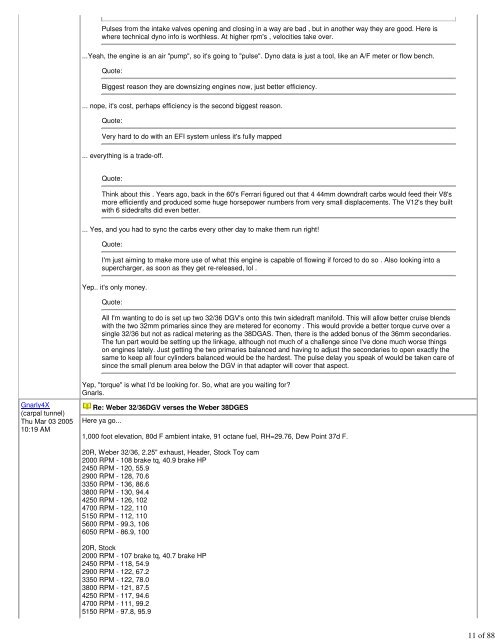You also want an ePaper? Increase the reach of your titles
YUMPU automatically turns print PDFs into web optimized ePapers that Google loves.
Gnarly4X<br />
(carpal tunnel)<br />
Thu Mar 03 2005<br />
10:19 AM<br />
Pulses from <strong>the</strong> intake valves opening and closing in a way are bad , but in ano<strong>the</strong>r way <strong>the</strong>y are good. Here is<br />
where technical dyno info is worthless. At higher rpm's , velocities take over.<br />
...Yeah, <strong>the</strong> engine is an air "pump", so it's going to "pulse". Dyno data is just a tool, like an A/F meter or flow bench.<br />
Quote:<br />
Biggest reason <strong>the</strong>y are downsizing engines now, just better efficiency.<br />
... nope, it's cost, perhaps efficiency is <strong>the</strong> second biggest reason.<br />
Quote:<br />
Very hard to do with an EFI system unless it's fully mapped<br />
... everything is a trade-off.<br />
Quote:<br />
Think about this . Years ago, back in <strong>the</strong> 60's Ferrari figured out that 4 44mm downdraft carbs would feed <strong>the</strong>ir V8's<br />
more efficiently and produced some huge horsepower numbers from very small displacements. The V12's <strong>the</strong>y built<br />
with 6 sidedrafts did even better.<br />
... Yes, and you had to sync <strong>the</strong> carbs every o<strong>the</strong>r day to make <strong>the</strong>m run right!<br />
Quote:<br />
I'm just aiming to make more use of what this engine is capable of flowing if forced to do so . Also looking into a<br />
supercharger, as soon as <strong>the</strong>y get re-released, lol .<br />
Yep.. it's only money.<br />
Quote:<br />
All I'm wanting to do is set up two <strong>32</strong>/36 DGV's onto this twin sidedraft manifold. This will allow better cruise blends<br />
with <strong>the</strong> two <strong>32</strong>mm primaries since <strong>the</strong>y are metered for economy . This would provide a better torque curve over a<br />
single <strong>32</strong>/36 but not as radical metering as <strong>the</strong> 38DGAS. Then, <strong>the</strong>re is <strong>the</strong> added bonus of <strong>the</strong> 36mm secondaries.<br />
The fun part would be setting up <strong>the</strong> linkage, although not much of a challenge since I've done much worse things<br />
on engines lately. Just getting <strong>the</strong> two primaries balanced and having to adjust <strong>the</strong> secondaries to open exactly <strong>the</strong><br />
same to keep all four cylinders balanced would be <strong>the</strong> hardest. The pulse delay you speak of would be taken care of<br />
since <strong>the</strong> small plenum area below <strong>the</strong> DGV in that adapter will cover that aspect.<br />
Yep, "torque" is what I'd be looking for. So, what are you waiting for?<br />
Gnarls.<br />
Re: <strong>Weber</strong> <strong>32</strong>/<strong>36DGV</strong> <strong>verses</strong> <strong>the</strong> <strong>Weber</strong> <strong>38DGES</strong><br />
Here ya go...<br />
1,000 foot elevation, 80d F ambient intake, 91 octane fuel, RH=29.76, Dew Point 37d F.<br />
20R, <strong>Weber</strong> <strong>32</strong>/36, 2.25" exhaust, Header, Stock Toy cam<br />
2000 RPM - 108 brake tq, 40.9 brake HP<br />
2450 RPM - 120, 55.9<br />
2900 RPM - 128, 70.6<br />
3350 RPM - 136, 86.6<br />
3800 RPM - 130, 94.4<br />
4250 RPM - 126, 102<br />
4700 RPM - 122, 110<br />
5150 RPM - 112, 110<br />
5600 RPM - 99.3, 106<br />
6050 RPM - 86.9, 100<br />
20R, Stock<br />
2000 RPM - 107 brake tq, 40.7 brake HP<br />
2450 RPM - 118, 54.9<br />
2900 RPM - 122, 67.2<br />
3350 RPM - 122, 78.0<br />
3800 RPM - 121, 87.5<br />
4250 RPM - 117, 94.6<br />
4700 RPM - 111, 99.2<br />
5150 RPM - 97.8, 95.9<br />
11 of 88


